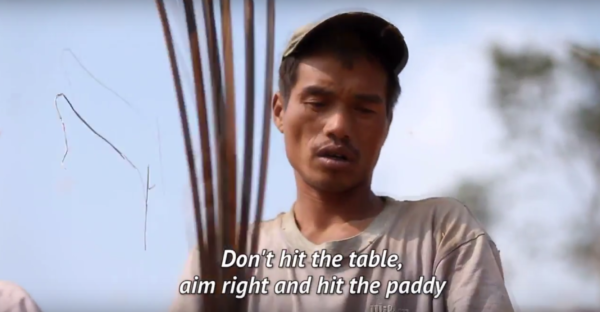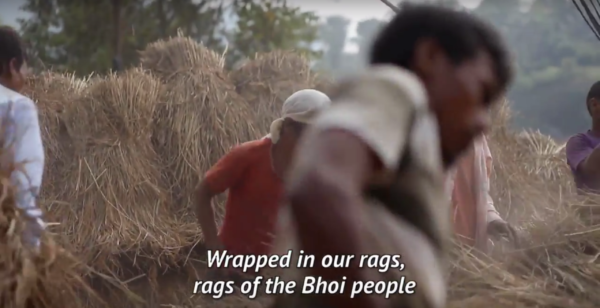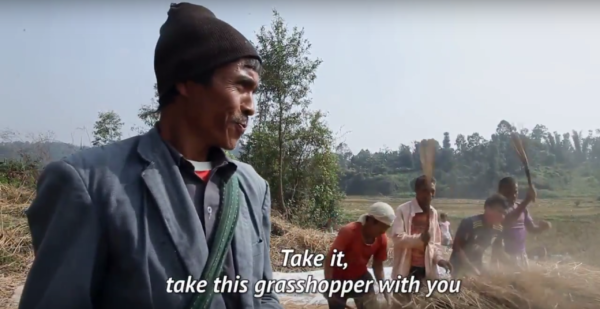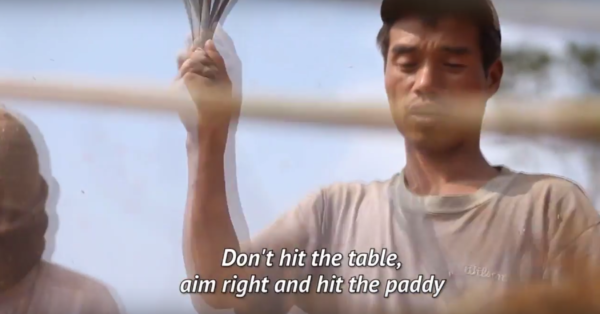Max Arne Kramer
Brief Life of Insects, Escaping Museums – Lak(h)empong Diaries, Sounds from the Truck Country and Kings Have Their Resorts, People Have Their Songs. These four titles of a series of six documentary films make you instantly wonder what may hold them together. Looking for orientation you could read the title of the film-series again – Songs to Live By – and perhaps find a synopsis saying that the films are dealing with indigenous communities in the North East of India. Perhaps you are even more puzzled now by the range of associations from fauna via commerce to state-institutions.
In some ways this series is an exploration of a new form of documentary by Shillong based Hindi poet, filmmaker and editor Tarun Bhartiya. His former filmic engagements include When the Hens Crow (2013) and Darjeeling Himalayan Railway (2010). He won the Indian National Film Award in editing for his work In Camera (2009). The two films he edited for Sanjay Kak Jashn-e-Azadi (2007) and Red Ants Dream (2013) are significant contributions to a cinema of resistance against the state driven violence in Kashmir and in the jungles of Odisha. Both films show a highly contextualized variation between ‚distancing effects’ and more realist representations of political struggle.
With the series on the North-East Bhartiya is exploring new grounds, both formally and in terms of a politics of representation. The titles already suggest that the series produced by the Meghalay Government Department of Arts and Culture is in some ways neither about art nor about culture. At least not in the way most of us would imagine a film to be about a culture or about a form of art. We may more fruitfully engage with this series as an attempt to take a close look at various song-performances and what they tell us about history, memory, power, and social transformation.
The songs seem to be part of a fragile memory that is fading in the rapidly changing societies of the North East. To give one example from the first film of the series „The Brief Life of Insects“. The farmer and musician Albinus Karkongor cannot remember a song he sang threshing paddy just a few months after the filmmaker captured a first performance of the paddy-song and asked him to sing it again for the camera. Even a recording that Bhartiya has done with his mobile phone was of no help to make Albinus remember the lyrics. The song was embedded into a bodily memory of the work on the field which is beautifully captured by the camera and the editing evoking the rhythm of the threshing while portraying the dynamics of the collective work.
In the last film of the cycle „Kings Have Their Resorts, People Have Their Songs“ the song Long Hai was restaged partly for the camera. A woman from Syndai asks: How can we preserve the song if we don’t cultivate millet. A voice from the side of the camera (perhaps the filmmaker) answers: You don’t have to actually cultivate millet. The song or tradition that has faded or is about to fade opens up questions of archive and preservation: who is recording for whom? Since hardly any written source exists in these oral traditions one further question becomes particularly interesting: what is the role of documentary film as an archive of these practices?
All films of the series are formally invested in the multi-sensorial experiences which go into the collective performances of these mostly work-related songs. There is the constant strive for gathering a sensibility not only of the particular – and sometimes lost – ritual context, but also of the films entanglement in the actualities that are produced through the camera. These interventions of the filmmaker are marked through subtle editing strategies that suggest how the presence of the film team re-invoked a ritual context gone by.
While the ritual setting of the Long Hai song was dependent on the harvest of millet, we see a group of women and men discussing how difficult it would be to re-stage this tradition in a time where betel nuts are produced for profit in Syndai. A telephone call from Shillong, the capital of Meghalaya, is signalling the distance of the filmmaker from the everyday context of Syndai and his interest to record something that is no longer practiced. However, some voices in his films make clear that what is gone is an absence that is felt as a lack. The new betel work has suspended a system of voluntary exchange of labour that has been central to the meaning of Long Hai. The films point towards a number of processes of commodification that have transformed the basis of living amongst the communities.
I understand this as the intervention of the filmmaker into a fragile memory. The camera gets entangled in the collective desire to restage something that is lost. But that ‘something’ is not framed within the familiar notion of culture as the way of life of a classifiable group. Instead, Bhartiyas films mobilise a lack from with-out by articulating an aesthetic potential of communality in a sceptical and always curious voice.
The titles of the films are:
- BRIEF LIFE OF INSECTS
22 mins | Ktien Nongtung with English subtitles
- LOVE SONGS OF SOTJAK AND RINGJENG
17 mins | A.chik with English subtitles
- ESCAPING MUSEUMS – LAK(H)EMPONG DIARIES
29 mins | Ktien Nongtung and Sohra Khasi with English subtitles
- SONGS & SECRETS IN SADOLPARA
20 mins | A.chik with English subtitles
- SOUNDS FROM THE TRUCK COUNTRY
39 mins | Pnar with English subtitles
- KINGS HAVE THEIR RESORTS, PEOPLE HAVE THEIR SONGS
40 mins | War Jaintia & Pnar with English subtitles
Max Arne Kramer

Am 22.04.2015 fand in den Räumen der Humboldt-Universität zu Berlin eine von Dr. Sanaa Alimia und der Berlin Graduate School Muslim Cultures and Societies (BGSMCS) gemeinsam organisierte Filmvorstellung zum Kaschmirkonflikt statt. Der Film „Bring Him Back“ (2015) behandelt den politischen Einsatz von Shamli Begum, der Mutter des 1984 in Indien gehängten kaschmirischen Seperatistenführers Maqbool Bhat. Seit über dreißig Jahre kämpft sie für die Rückführung des Leichnams ihres Sohns in das leer stehende Grab auf dem Märtyrerfriedhof Srinagars, der Sommerhauptstadt des indisch-verwalteten Teil des umstrittenen Gebiets. Die Zuschauer wurden durch Fahad Shahs Film mit der biopolitischen Dimension des Kaschmirkonflikts konfrontiert: er zeigt, wie nicht nur der Mobilität der Lebenden in einem militärisch besetzten Land enge Grenzen gesetzt sind, sondern auch, dass durch die Bewegung eines Leichnams aus der Sicht staatlicher Entscheidungsträger unkontrollierbare politische Passionen unter der Bevölkerung ‚entflammen‘ könnte. Es folgte eine Diskussion mit dem Filmemacher und Medienschaffenden Fahad Shah, Herausgeber des bekannten kaschmirischen Online-Journals „The Kashmir Walla„. Shah betonte die Notwendigkeit für die kaschmirische Jugend, auf allen Ebenen des medialen und kulturellen Ausdrucks aktiv zu werden. Sein Film, so Shah, sei eine wichtige Ressource der Erinnerungspolitk seiner Generation, der sich immer mehr Kashmiris bedienen, um „die orientalistischen Bilder des indischen Kolonialismus anzufechten“.
Eine neuere Publikation von Shah „Of Occupation and Resistance“ präsentiert Essays vorwiegend junger Kashmiris aus der Generation der ‚Kashmiri Intifada‘ (ab 2010), die ihre Erinnerungen an die Kindheit in einem Konfliktgebiet durch verschiedene Formen zum Ausdruck bringen.
News » National
Published: January 16, 2015 08:08 IST | Updated: January 17, 2015 00:58 IST
Furore as Leela Samson quits
Even as the Government challenged Central Board of Film Certification (CBFC) `chairperson’ Leela Samson to prove her allegations, her decision to step down is expected to trigger a slew of resignations from the Board over the weekend. Already, one member, Ira Bhasker, is learnt to have stepped down.
Citing „interference, coercion’’ besides corruption of panel members and officers of the organization appointed by the Information & Broadcasting (I&B) Ministry, Ms. Samson sent in her resignation on Thursday night soon after word came that the Film Certification Appellate Tribunal (FCAT) had cleared the release of the film MSG – The Messenger of God featuring Dera Saccha Sauda chief Gurmeet Ram Rahim Singh Insan.
The film was initially scheduled for release today but was postponed after the `Examining Committee’ and the `Revising Committee’ of the CBFC rejected certification for the film. The `Revising Committee’ referred the film to FCAT last Tuesday and what has stunned Ms. Samson and other members of the Board is the speed at which the tribunal cleared the film.
„It usually takes FCAT several weeks to clear a film referred to it,’’ said one member who did not want to be quoted.
Meanwhile, the premiere of the film that was hurriedly sought to be organised in the satellite township of Gurgaon, adjoining Delhi, on Friday evening was cancelled at the eleventh hour as necessary formalities had not been completed. The Dera chief told his followers who had gathered there in large numbers that the date of the premiere and release of the film would be announced later. Prior to FCAT approval, the Dera had rescheduled the release of the film for January 23 but from what Ram Rahim told his followers that could also now change.
The FCAT’s decision drew sporadic protests in many parts of Punjab and Haryana. The Akal Takht had in December sought a ban on the movie by the godman who had first hurt the sentiments of the community when he had allegedly dressed up like the Sikh guru, Guru Gobind Singh. Several radical Sikh organizations like the Dal Khalsa and the Peer Mohammad faction of the All India Sikh Students Federation had also supported the demand then.
As the Government drew flak for the charges levelled by Ms. Samson, Union Minister of State for I&B Rajyavardhan Rathore countered by asking her to show a „letter or an SMS’’ to prove that the government had been ignoring the CBFC’s requests and preventing the Board from meeting for the past nine months. Two CBFC members confirmed to The Hindu that the Board had not met even once in the past nine months.
Ms. Samson’s three-year term and that of many of the Board members had ended in May 2014. In July, the Ministry had informed the Board members that their term was being extended „till further notice“.
Recently, the Board had also come under pressure from members of the Sangh Parivar over the Amir Khan-starrer `PK‘. At that point, Ms. Samson had gone on record stating that no scene from the film would be removed as it had already been released.
In the midst of the controversy, she had said over a fortnight ago that: „Every film may hurt religious sentiments of somebody or the other. We can’t remove scenes unnecessarily because there is something called creative endeavour where people present things in their own way. We have already given certificate to `PK‘ and we can’t remove anything now because it’s already out for public viewing.“
Keywords: Leela Samson, Censor Board, Messenger of God, Dera Saccha Sauda
View comments (74)
Printable version | Jan 17, 2015 12:28:48 PM | http://www.thehindu.com/news/national/censor-board-chief-leela-samson-decides-to-quit/article6792822.ece
© The Hindu
Related articles: PK Controversy: 5 reasons why the film must be banned (India Today)
PK: Controversies and laurels (The Hindu online)
Das 11. Indische Filmfestival in Stuttgart, 17.-20. Juli 2014
Ein Festivalbericht von Fritzi-Marie Titzmann und Alexandra Schott
Im Laufe einer Dekade hat sich das Indische Filmfestival in Stuttgart einen festen Platz in der Welt der indischen Filmfestivals in Europa und im jährlichen Kalender Indien-Begeisterter gesichert. Das Festival, das bis einschließlich 2011 unter dem Titel „Bollywood and Beyond“ lief, konnte auch in diesem Jahr wieder mit einem abwechslungsreichen Filmprogramm überzeugen. Das Rahmenprogramm reichte von den sogenannten „Tea Talks“, u.a. zur Parlamentswahl 2014 in Indien oder dem boomenden Online-Heiratsmarkt, über Tanzworkshops bis hin zu kleinen Musik- und Tanzvorführungen sowie dem Shah Rukh Khan Wunschfilm.
Das komplette Programm mit Kurzbeschreibungen zu allen Filmen findet sich unter:
www.indisches-filmfestival.de.
Lesen Sie den kompletten Bericht auf dem Informationsportal zu Südasien suedasien.info unter:
You watched the wrenching documentary. You posted your outrage on Twitter. But are you good for more than a few easy keystrokes of hashtag activism?
Participant Media and some powerful partners need to know.
For the last year Participant, an activist entertainment company that delivers movies with a message, has been quietly working with the Bill & Melinda Gates Foundation, the Knight Foundation and the University of Southern California’s Annenberg School for Communication and Journalism to answer a question vexing those who would use media to change the world.
That is, what actually gets people moving? Do grant-supported media projects incite change, or are they simply an expensive way of preaching to the choir?
…
Read the full article here: http://www.nytimes.com/2014/07/07/business/media/participant-index-seeks-to-determine-why-one-film-spurs-activism-while-others-falter.html?_r=0
Die neue Ausgabe des MASALA-Newsletters (2/2014) enthält unter anderem drei Beiträge zum Thema Film in Indien:
- Wo es kein Bollywood gibt: eine ethnologische Reise zum „indigenen“ Kino Indiens (Markus Schleiter)
- Neue Räume und Praktiken politischer Jugendproteste im Hindi-Film (Nadja-Christina Schneider)
- Typisch Bollywood? Der Diskurs über Bollywood in deutschen Qualitäts-Tageszeitungen (Katja Molis)
Link: Newsletter Virtuelle Fachbibliothek Südasien (Uni Heidelberg)
PDF: Newsletter Masala, Jg. 9, Nr. 2 (2014)
von Max Kramer
A couple of days ago, on the 13th and the 14th of February (2014), I was attending the annual conference of the Gorakhpur Film Festival Movement (GFM) which was held at the Gandhi Peace Foundation in Delhi. Since its inception in the year 2006 the GFM spread to fourteen cities and towns in northern India, most of them located in the economically weaker areas of eastern Uttar Pradesh, Bihar and Rajasthan. The festival movement (mind the second component: movement) thrives due to the conjunction of new technologies and innovative work: digital projectors make new screening venues reachable and the new connectivities established between local film societies and the central highly mobile unit called ‚the group‘, which is based in Delhi, seem to generate the continuity and rapid expansion. ‚The group‘ promotes the concept of an inter-media platform, combining films with poetry, painting, music, academic lectures and film-related publishing in Hindi. During this year’s conference, the participants were reflecting upon their past work and planning their future strategies. Representatives of about a dozen cities were present. Among those invited to join the network this year was Mohad Gani, a self-taught filmmaker from Mathura who proposed to launch a local edition of the Cinema of Resistance, as the festivals of the GFM are called. I want to tell a few stories surrounding his film Quaid (Imprisoned, 2014) as they disclose some potentials of an independent digital film culture and the new ways of public engagement it relates to. Such an understanding should, however, be properly contextualized; in other words, we will start our journey from Mathura.
Most people in South Asia know Mathura for the adventurous stories of Lord Krishna, the amorous god, the war consultant and the ‚cunning‘ child. Until I saw Quaid, the only films from Mathura I knew belong, perhaps, to the most South Asian of all genres: the yatra-film. Images of temples invite the believer to enter a mediated pilgrimage, a voiceover introduces us to the mythologies of the place while the eyes of divine statues bestow auspicious looks.
However, with Mohad Gani’s fiercely independent film, something rather different emerged from the banks of the Yamuna River. This film is remarkable not only due to its place of origin, but because it tells us something about the potentials of filmmaking in our age. It reminds us that, sometimes, you need nothing more than a relevant subject, a dedicated theater group, your house, an elementary school, a self-taught filmmaker and 2000 Rupees (around 25 €) to make a good movie.
The narrative, based on a short story by Gyan Prakash Vivek, is about a strong-willed boy who is caught in the webs of a malfunctioning school and the business of religiously legitimized quacks. At school, the boy’s creative wit is more feared than being acknowledged. This initiates a destructive circle where, through the ostracism of his Hindi teacher, the boy closes himself off and turns more and more aggressive towards his surroundings. Instead of looking into the dynamics of the conflict, his parents consult a tantric baba who advises them to lock the boy into a room until he would come to his senses again. The plot takes a turn when an open-minded teacher joins the local school. He learns about the locked up boy on the roof and carefully attempts to establish contact with him. He slowly builds up trust and reassembles the causes which led to the boy’s imprisonment.
This film can perhaps best be understood as a cultural artifact circulating in a web of stories weaved around it. Beyond the screens of commercially ‚big‘ cinema, the filmmakers often travel along with their films and discuss them with local audiences, thereby adding multiple layers of narrative to the meaning of the film performance. These layers may include the story of the production of the film or some biographical sketches of the professional struggle of the filmmakers.
Mohad Gani did not visit school for more than four years and elementary education in state run schools in non-metropolitan India is well known for its notoriously bad condition. When he was about fifteen years old, he taught himself how to read and write Hindi. Together with some friends, Gani launched a street theater group called Sanket Rangtoli. He wanted to make films but he did not have the money to buy a camera. Getting admission to a film school was, of course, out of question. Again Gani taught himself to edit and direct a film. With his sewing work and the help of some friends he managed to save enough money to buy a camera. Together with the street theater group and some family members, he started producing Quaid about a year ago. They also set up a local film society called Jan Cinema (People’s Cinema) and bought a projector. With this projector the group travels through the city, bringing their films to the audiences they want to address, just as they have done before with the street theater performances. These films are, of course, not just shown, but also discussed with the audience.
Technical stories about minimal budget projects are often fun to hear and sometimes instructive to understand the potentials of digital filmmaking. Just one example: for building a camera dolly the crew put wheels under a table and fixed a chair on top of it. There are some aspects of a ‚third cinema‘ (e.g. Solanas/Gettino/Espinosa) which only came to a broader realization after digital film technology really took off. One way to understand this is in relation to the mobilities of independent film practices. Just as the street theater, films such as Quaid and their crews are coming to your part of town and maybe screen their next film on your neighbour’s wall. They provide us with a glimpse of emerging practices of political filmmaking in South Asia. By engaging in collectively negotiated processes of meaning, they pose a challenge to established modes of production. The next months will show how far Quaid will travel and how it will engage with audiences in South Asia and perhaps beyond. In the meantime, Jan Cinema is already planning their next feature film.
Find an additional article („Cinema of Resistance“) on this Topic online under: http://www.hardnewsmedia.com/2011/10/4174
Experimenteller Dokumentarfilm, Indien 2008, 28 min
Regie: Ambarien Al Qadar
Kurzessay von Anna Oechslen
Lesen Sie den kompletten Kurzessay zum Film mit dem Titel „Im Schatten der imaginären Über-Mutter“ online unter: https://wikis.hu-berlin.de/mediaiaaw/images/6/6a/Anna_Oechslen_2014_Im_Schatten_der_imagin%C3%A4ren_%C3%9Cber-Mutter.pdf
Sie finden den Trailer zum Film online auf der Videoplattform Vimeo unter: http://vimeo.com/10574837
Dokumentarfilm, Deutschland 2013, 93 min
Regie: Marco Wilms
Rezension von Jamila Adeli
Der Dokumentarfilm Art War von Marco Wilms beschäftigt sich mit dem Arabischen Frühling aus dem Blickwinkel junger Künstler in Kairo – und damit aus einer anderen Perspektive als die gängigen Nachrichtenmedien. Im Mittelpunkt stehen die Bilder und Texte, die im Laufe der Revolution im öffentlichen Raum an die Mauern Kairos gezeichnet oder gesprüht werden: Märtyrerbilder junger Ägypter, die während der Unruhen ums Leben gekommen sind; poetische Verse und Kommentare, politische Botschaften in Form eines prägnanten Graffitis. Dass es nicht selbstverständlich ist, in Kairo einen visuellen Abdruck vom persönlichem Ausdruck in der urbanen Öffentlichkeit zu sehen, ist immer wieder Thema derzeitiger Debatten. Die Arbeit Impressions of Cairo (2010) der in Berlin lebenden Künstlerin Nadia Kaabi Linke zeigt diesen Umstand sehr anschaulich (http://www.nadiakaabilinke.com/work/2010/cairo/cairo.html).
Der Film ist ein gelungenes Beispiel, um die gesellschaftliche Wirkkraft von Bildern (hierunter zählen auch die Sprachbilder von Gedichten und Liedtexten) und deren Interaktion mit Individuen im öffentlichen Raum zu thematisieren. Er zeigt am Beispiel Kairos, wie unterschiedliche Medien künstlerisch dazu genutzt werden, um zunächst gegen das herrschende Regime und dann gegen den Verlauf der Revolution selbst zu protestieren. Bilder und Texte der Jugendkultur Ägyptens sind damit zum Spiegel gesellschaftlicher Transformationsprozesse geworden.
Interessant ist hierbei, wie sich die einzelnen Medienformate aufeinander beziehen und den Verlauf der Revolution auf verschiedenen narrativen Ebenen verbinden und kommentieren. Zum Beispiel wird ein militärkritisches Graffiti von anonymen Nationalisten durch malerische Veränderungen „entschärft“, die Aktion wird gefilmt, mit marschähnlicher Musik unterlegt und per youtube als „Gegenschlag“ gesendet. Marco Wilms portraitiert mit Art War einen öffentlichen Raum, in dem eine junge Generation ihre Ansichten sprichwörtlich auf Strassenwände projiziert und diesen damit als Ort der Meinungsbilder proklamiert. Die Werke der Revolutionskünstler, wie sie im Film genannt werden, zeigen, wie mit zeitgenössischer Kunst politische und soziale Auseinandersetzungen geführt werden können – worin die eigentliche Stärke des Films liegt.
Sie finden den Trailer zum Film online auf der Videoplattform Youtube unter: http://www.youtube.com/watch?v=GQkTBxXLLnM
Auf der Suche nach dem richtigen Leben
von Nadja-Christina Schneider
Das 10. Indische Filmfestival in Stuttgart präsentierte vom 17.-21. Juli 2013 ein spannendes und vielfältiges Programm. Mehrere Festivalbeiträge behandelten existenzielle Fragen, wie sie gegenwärtig überall auf der Welt diskutiert werden: Wie können wir uns dem permanenten Konsum-, Leistungs- und Selbstoptimierungsdruck entziehen? Wie finden junge Menschen heraus, was das „richtige Leben“ für sie sein kann, wenn die Familie ganz andere Pläne für sie verfolgt? Fast ohne pädagogischen Zeigefinger, dafür mit großer Lust an formal-ästhetischen Experimenten, großartigen Bildern und Farben, neuen Perspektiven auf gesellschaftliche Realitäten und interessanten Charakteren, die einen weit über das Festivalende hinaus begleiten.
Lesen Sie den gesamten Artikel auf der Internetseite suedasien.info – das Informationsportal zu Südasien unter: http://www.suedasien.info/analysen/3077






